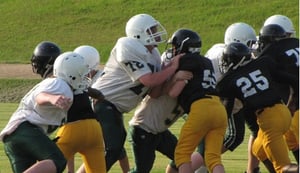 A concussion is a mild form of Traumatic Brain Injury (TBI) caused by a bump, blow, or jolt to the head. Concussions can also occur from a fall or a blow to the body that causes the head to move rapidly back and forth.
A concussion is a mild form of Traumatic Brain Injury (TBI) caused by a bump, blow, or jolt to the head. Concussions can also occur from a fall or a blow to the body that causes the head to move rapidly back and forth.
It is a common opinion that concussions happen mostly to football players. However, they can also occur while playing other contact sports such as soccer, as a result of a vehicular accident, or during a fall.
Signs and Symptoms
Most people assume that you have to lose consciousness to experience a concussion, but this is not always true. If you think your child may have suffered a concussion, pay close attention for symptoms which may include:
- Headache
- Difficulty concentrating or following directions
- Appearing confused or dazed
- Impaired memory
- Coordination or balance
- Mood swings or changes in behavior
- Nausea
- Ringing in the ears
- Changes in sleep
- Blurry vision
- Sensitivity to light and noise
Medical Follow-Up
Always remember: if you suspect that your child may have a concussion, you MUST seek medical attention IMMEDIATELY.
The doctor may order an MRI scan or a CT scan of your brain to check for serious injuries. If the person with a concussion experiences seizures, an electroencephalogram (EEG), may also be performed to monitor brain waves. Some doctors may use a particular eye test that detects signs of a concussion, such as changes in pupil size, eye movements, and sensitivity to light.
In more severe cases, a dangerous blood clot may form on the brain, which can be life-threatening. Call 911 or take your child to the emergency room right away if he or she appears to have the following symptoms:
- Drowsiness or can’t wake up
- One pupil is larger than the other
- Seizure activity
- Increased confusion
- Slurred speech
- Headache worsens
- Not eating
- Persistent vomiting
Treatment
Treatment for a concussion usually involves rest or taking a “brain break,” and may include the following:
- Getting adequate sleep
- Eliminating electronics (e.g., cell phone, computer, video games)
- Limited to no homework
- Limited to no reading
- Limited to no watching TV
It is crucial that taking this mental timeout, per the doctor’s directions is followed to allow the brain to heal effectively. It may take several weeks for complete recovery.
Children and Concussions
Sports-Related Injuries
For a child to safely return to sports and other restricted activities after a concussion, a doctor’s permission is required. Experiencing a second concussion before the first concussion is healed can cause a condition known as Second Impact Syndrome, which can increase the chances of severe brain swelling and could be fatal.
Many states in the U.S. have “return to play laws” for youth sports. In Ohio, for example, a player who is suspected of having experienced a concussion is immediately removed from play. The player cannot return until at least 24 hours after the incident and must have a written clearance from a physician for the athlete to resume activity.
While playing sports, it is crucial to take the necessary precautions to help to avoid a concussion. Inform the coach if your child has had a previous concussion. Protective gear must always be worn when engaging in high-risk activities such as riding bikes, skateboarding, and all contact sports. Helmets can help to lessen the effects of a head injury but do not eliminate the risk of concussion.
Fall-Related Injuries
Babies and toddlers are very susceptible to falls and head injuries, so it is vital to implement safety measures such as using gates to limit access to stairs. They must be continuously supervised while playing in the home or at the playground. Car/booster seats must be installed properly.
The good news is that there has been more awareness in recent years regarding how concussions occur, the symptoms to be aware of, and how to treat concussions.









